Everything To Know About Attending Oktoberfest In Munich

Any self-proclaimed beer aficionado likely has Oktoberfest on their bucket list, considering the two-and-a-half-week affair draws in about 6 million annual visitors. With just as many liters of beer being served onsite, it's no secret that this is an essential fest, one that draws tourists from all over the world. Sure, from the outside it might seem like little more than a mass drinking event, but it's history goes much deeper. When Oktoberfest (locally called Wiesn) originally launched in 1810, it was as an extended celebration for a royal wedding.
First-timers could undoubtedly benefit from pro-tips designed to make the entire experience smoother — while, of course, leaving room for spontaneous unpredictabilities. From booking flights to how to treat security, what to wear to which areas of the festival are most worth your time, we're here to set you on the right path. So, slip into your most comfortable lederhosen, raise a stein and read on, for everything you need to know before attending Munich's annual Oktoberfest.
Read more: Michelin-Starred Restaurants You Should Visit At Least Once
Consult A Map Of The Festival Space Before Arriving
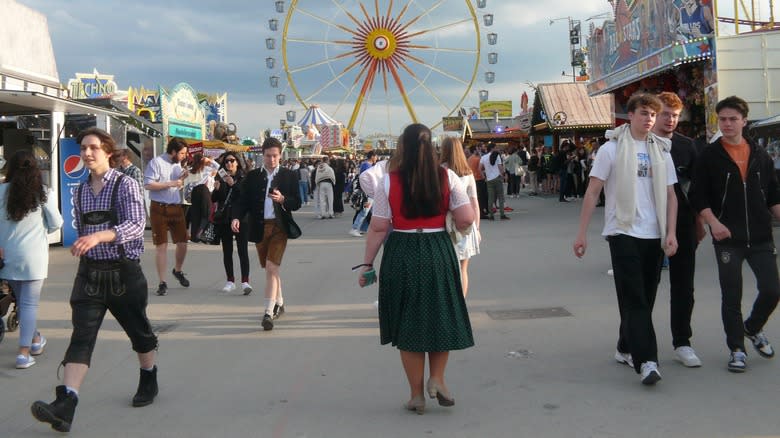
The oval-shaped Theresienwise encompasses 42 hectares of area (about 60 soccer fields), which means you'll want to have at least a vague idea of the general layout. Be sure to plan a meeting spot with your friends ahead of time in case you split up. Your sense of direction is sure to get infinitely blurrier as the day progresses. There are several entrances to the grounds, so determine which is most convenient based on your arrival location, not to mention, which is closest to the tent you are hoping to enter.
The Oktoberfest grounds consist of two main parallel roads that divide the space into beer tents and rides. Smaller perpendicular roads allow people to make their way from one area to the other. The southern area of the Theresienwiese is usually the site of the Oide Wiesn, which offers a more traditional atmosphere and old-timey feel. If you're totally lost, try using the Bavaria statue on the west side of the field as a landmark to orient yourself.
Learn About The Different Tents
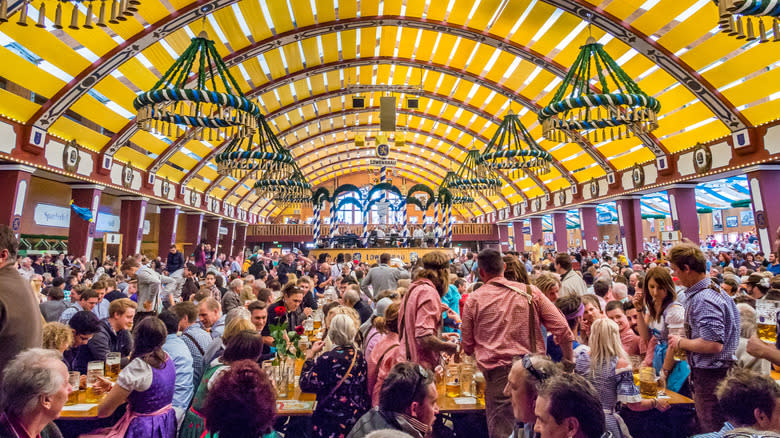
Many people imagine that Oktoberfest goes down in one giant space. While the festival takes place in a closed-off area called the Theresienwiese, within it there are dozens of tents, each with its own distinctive atmosphere. They're oversized, with combined indoor and outdoor capacities ranging from a few thousand to 10,000 people. Only Munich's six major breweries are permitted to serve beer. Each one has a tent as well as kegs in others, for a total of 17 large tents and 21 smaller ones. To get a true taste of the festivities, be sure to visit more than one.
Among the central beer tents, Hofbräu is the most well-known overseas, which means it's often the first stop for tourists. Check it out if you're a fan but be sure to spend time in another tent for a rounded experience. Try the Hacker Festzelt, a visually dazzling and popular place to sing and dance with the crowds under a blue sky decorated with clouds and stars, aka Himmel der Bayern. For a taste of history, don't miss the Augustiner Festhalle, where beer from Munich's oldest brewery flows. The other primary beer tents are Löwenbräu, Paulaner, and Spaten.
If beer isn't your thing, check out the Kufflers Weinzelt for wine, or try sweet delicacies at the Kaiserschmarrn tent. If you want something besides hearty plates of meat, visit the Fischer-Vroni, where you can try Bavarian specialties such as Steckerlfisch, or fish on a stick.
Save Time To Explore The Old Wiesn And Outdoor Attractions
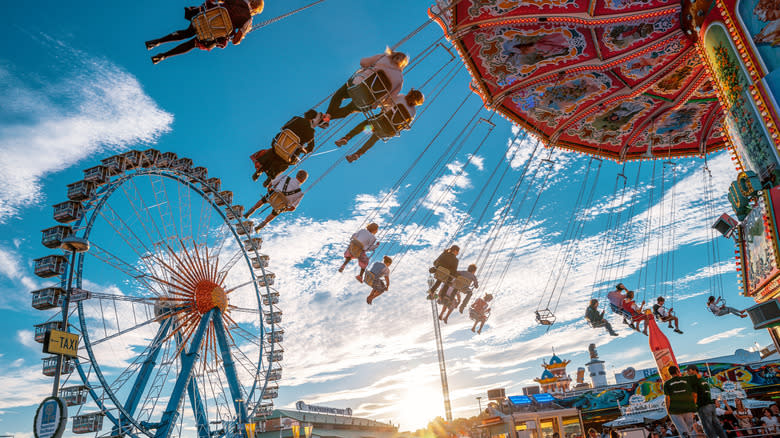
While you'll undoubtedly want to spend plenty of time drinking beer in the tents and dancing to Bavarian music with thousands of strangers, that's not the entire Oktoberfest experience. Find a seat in one of the beer gardens located by most of the tents, especially if the fall weather is holding up. If you enjoy fair rides, make a point to check out some of the attractions, such as the giant Ferris wheel or swing carousel — ideally before you start drinking. For the more adventurous, the SkyFall drop tower or Five Loops rollercoaster are sure to spike your adrenaline.
Once you've had enough of all the heart-rate-boosting rides, take it down a notch with a visit to the Oide Wiesn. Usually located on the south end of the Theresienwiese, the area hosts historic tents and carnival stalls for a glimpse back in time. The contained area has a small entrance fee (€4, or $4.30 as of September 2023), which also helps keep some of the rowdier crowds away. Some of the sites include a museum tent (where you can find items and memorabilia from past Oktoberfests) as well as various musical tents.
Fit In By Wearing Traditional Garb
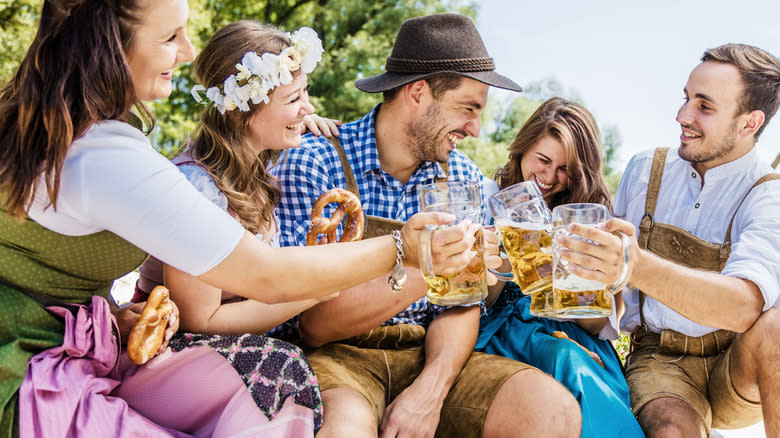
People have different opinions regarding what to wear at Oktoberfest; it ultimately comes down to what you're comfortable wearing. The event is undeniably a prime occasion to wear traditional Bavarian alpine clothing, known as Tracht in German. Note that Bavarians don't wear it every day; it is considered attire to wear for celebrations.
Men wear lederhosen (leather shorts with straps), as well as accessories like a white or checkered shirt, wool knee socks, and leather shoes. Meanwhile, women don a blouse and a dirndl, which is a dress with a fitted bodice and apron. It's all in the details; an apron with a bow tied on the left indicates the woman is single, whereas if it's on the right she's taken. Lederhosen for women is also an increasingly common trend, albeit one that steers away from the classic configuration.
In both cases, you can find anything from cheap polyester outfits to high-quality garments from classic Bavarian tailors. What you choose will depend on your budget, but do your best to avoid versions that do more to mock than praise the cultural attire. That means no excessively short dirndls or t-shirts with Lederhosen straps printed on the front. There's no obligation to wear Tracht, of course, although there aren't many other opportunities for it.
The Beer Is Stronger Than You're Accustomed To
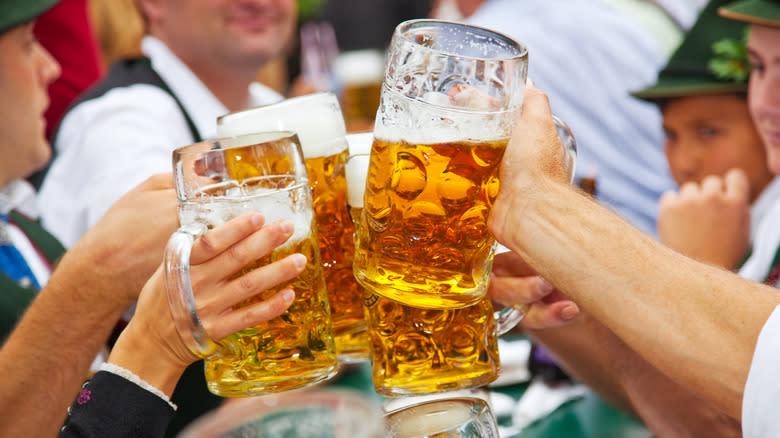
Whether you regularly pound back beers or sip a glass every now and then, everyone should take it easy for maximum fun. Oktoberfest beer can be pretty different from what you're accustomed to, as far as flavor and strength. The beverage has not always been brewed in the same style; dark beer (Dunkel) was once common, eventually paving the way for Märzen beer, an amber style brewed at the end of winter and matured until the fall festivities. To last the season, it was typically brewed at a higher ABV. Finally, in the '70s, lighter-hued lagers became the norm and are still served today (although Oktoberfest beers overseas are often ambers).
That being said, one should not assume that the pale color and drinkability of the beer equates to a lower alcohol content. Due to the brewing method, these beers clock in at more than 6 percent ABV — not to mention they only come in a 1-liter format (approximately 34 ounces). Also known as Festbier, these brews are exclusively meant for Oktoberfest, and each of Munich's main breweries creates a new one every year. The original producer was the Paulaner brewery, and it continues to make the celebratory beer using hops, and a combination of Munich malt and Pilsner malt.
Don't Go Too Hard Too Fast
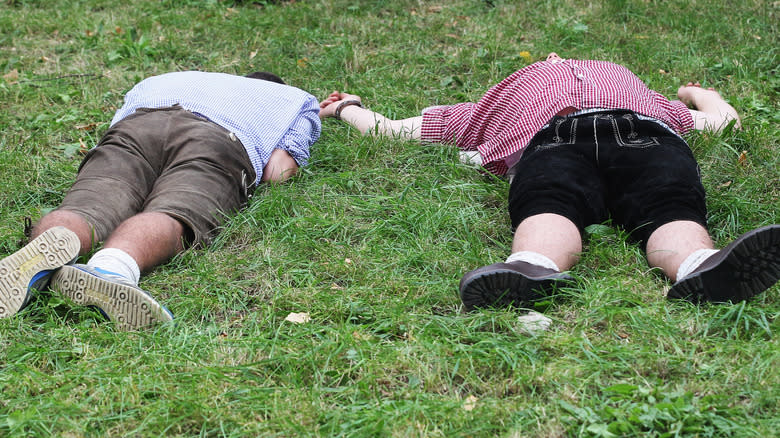
This might sound obvious, but it can be really easy to take the whole beer-drinking festivities too far. Many attendees start the day with beer, drink several more while waiting in line, and then get started on the hefty liter formats once they enter the tents. While their hangovers will likely be terrible, that's not the worst of it.
Even if you've been training for this brutal attack on your liver, it's easy to kick yourself into overdrive and end up passed out well before noon. You certainly won't be alone; there's even an area near the Bavaria statue known as puke hill (aka Kotzhügel in German). You really don't want to end up there — believe us. Not to mention, if you're notably drunk and acting rowdy, you may be escorted out by security.
Honestly, the best-case scenario is walking outside of the tent on your own two feet after the last call. Hydrate between beers (yes, even though water costs almost as much as beer) and make sure to eat before, during, and after the event. There's no point in flying all the way to Munich, spending an astronomical sum to attend the Wiesn, then not remembering any of it.
Plan Your Accommodations Before Arriving In Munich
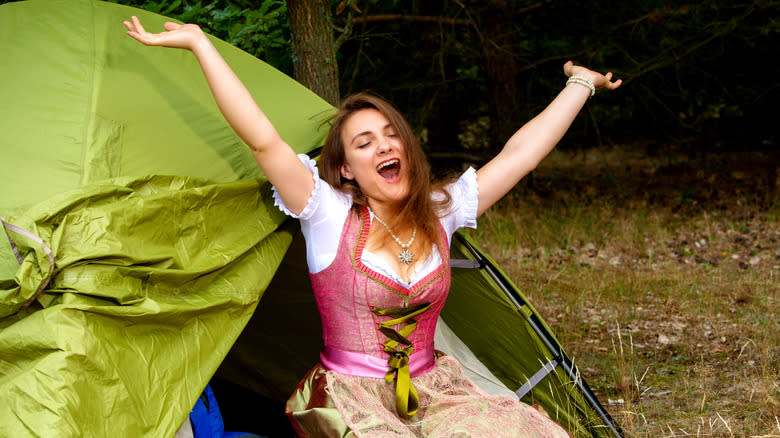
There's no way around it; a trip to Munich during Oktoberfest is infinitely more expensive than any other time. As soon as you decide to attend, you should book your accommodations. Based on your timing, options might be scarce or a little less so. If your dates are flexible, avoid weekends for a slightly less chaotic all-around experience.
Depending on your travel and beer-drinking attitude, there are several choices for your stay. Campsites on the outskirts of the city are set up for Oktoberfest guests, though you should be ready for adverse weather and travel time into the city ... not to mention thousands of rowdy campers. Hostels are a natural option for social crowds, and you're guaranteed to have a unique experience in a dorm room. Hotels are a no-brainer, although rates are seriously inflated. Some locals open up their homes to couchsurfers and Airbnb guests — or if your budget can accommodate it, a private apartment is the ultimate luxury.
The optimal location is within walking distance to the Theresienwiese, so you can avoid the crowded public transport or expensive taxis. Naturally, this is the priciest area too. If you're looking to visit Oktoberfest without making it the sole focus of your trip, staying on the outskirts of Munich or in a nearby town is a feasible alternative. Just be sure someone in the group knows which train to take home, to avoid a night in the train station.
Be Sure To Taste The Oktoberfest Favorites
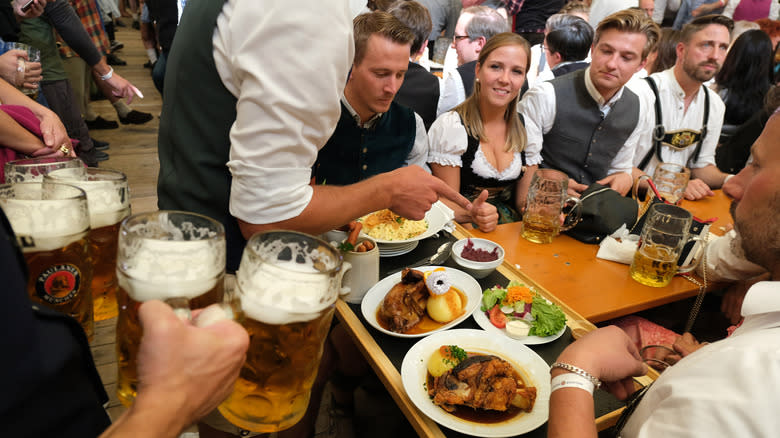
Much more than filling your stomach to avoid any sloppy outcomes, the food at Oktoberfest is another key part of the experience. Sure, you'll want to keep your budget in mind and ideally eat a meal before making your way to the event, but you can't miss out. Food on the festival grounds is usually a bit more affordable than what you'll find in the tents.
Once you're in the tents and have downed a beer or two, don't confuse the fullness you're feeling from the carbonation with the sustenance from your breakfast hours earlier. The success of your time at the Wiesn depends on you eating enough to soak up some of the beer. Not to mention, if your trip to Munich is short-lived and geared toward the festival, it will give you the chance to taste Bavarian specialties.
The numbers have varied significantly over the years, but typically between 500,000 and 800,000 roast chickens are served (usually by the half), which demonstrates the dish's popularity among guests. Other favorites include sausages, giant pretzels, roast duck, oxen, and pork knuckle. For a lighter affair share a Brotzeit platter, which typically consists of cold dishes like potato or sausage salad, cheese spreads, pickles, and cold meats. There's no shortage of sweet treats either, such as Kaiserschmarrn, a chopped pancake dish that comes with fruit purée.
Reserve A Table If You're Attending With Several People
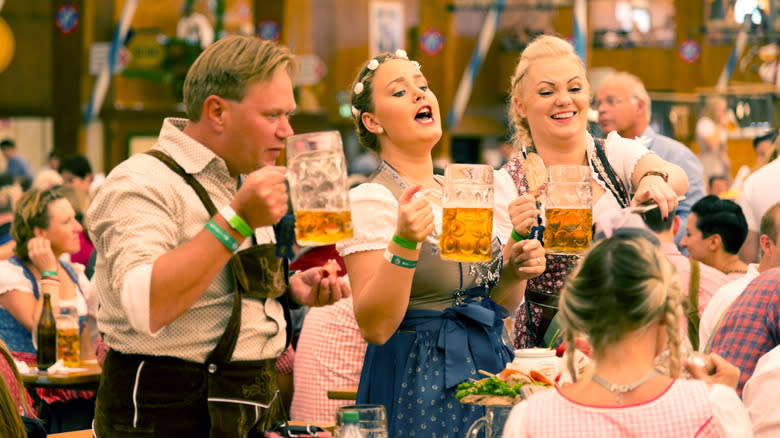
Although Oktoberfest is free to attend, there is still the option to reserve a table in a tent for a few hours. While two to three people should be able to find seats together at a shared table without reserving, it gets exponentially harder the larger the group. Reservations are only possible for the entire table, so you'll need to have eight to 10 people in tow. To guarantee the spot, guests must purchase vouchers that typically include two beers and half a roast chicken.
Of course, if it was as simple as buying a few vouchers, there would be no waiting in line. However, most tents have an allotted quarter saved for walk-in guests, and the numbers increase up to 50% on the weekends. Meanwhile, some seats are specifically reserved for returning guests, while others are first offered for Munich residents. The rules vary depending on the tent, so be flexible.
Regardless of the tent, reservations fill up fast, as companies and guests from past years swoop in as soon as possible to guarantee tables for large groups. Each tent has its own method of communication to book, including phone calls, emails, faxes, and online portals. Sign up for alerts to find out about sudden availabilities or join various online Oktoberfest groups to learn about last-minute spots as quickly as possible. If one comes up, don't hesitate.
Consider Visiting Outside Of Peak Times
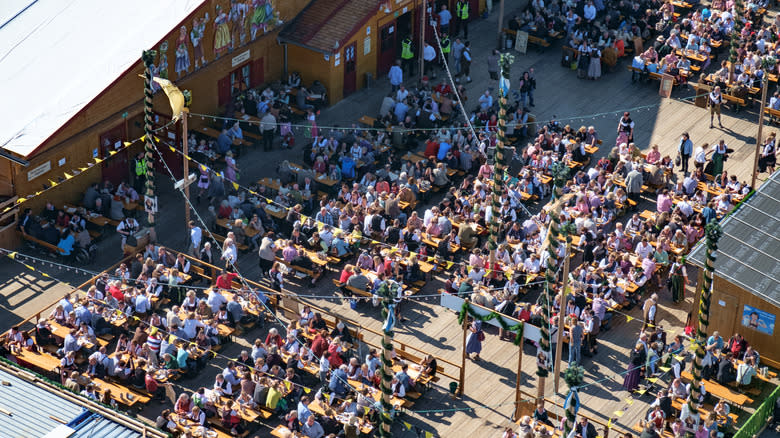
If you're already missing work to fly to Germany, try to avoid going to Oktoberfest at the busiest times. The first weekend involves the opening ceremony when the beer starts flowing from the kegs at noon, courtesy of the mayor. The symbolic moment takes place in the Schottenhamel Festhalle, so you can bet it's the busiest. While the opening weekend is undoubtedly full, it offers a close-up view of some of the more traditional elements. That being said, you'll only get your first beer after the mayor taps the keg, which means you'll be waiting long if you arrive when the grounds open.
The second weekend is known as the Italian weekend, due to the influx of visitors from the boot-shaped country. It is considered to be the busiest and rowdiest weekend and often a tricky time to find seating with a group. As for the last weekend, aside from the conclusion of the festivities, it tends to overlap with Germany Unity Day, a national holiday, meaning that the place gets packed.
If you want to reduce your time waiting in line and enjoy slightly less crowded tents, make your way to the fairgrounds in the earlier part of a weekday or on Sunday evenings. Most Germans aren't missing work to attend, so you'll have a better chance of getting a seat without a table reservation. The event is wild no matter the day of the week, but it's more manageable on a weekday.
Pick Up A Few Key Bavarian Words
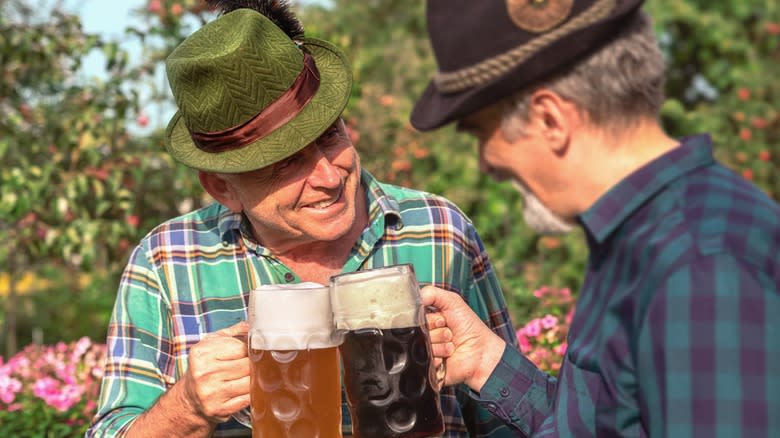
Obviously, no one is expecting tourists to speak German or understand the Bavarian dialect. This isn't really the kind of event that requires you to know a sequence of phrases to get what you want. That being said, a few words and phrases are frequently repeated in the Wiesn context, and knowing them will add to the overall experience.
For starters, Bavarians often greet each other by saying "Servus," although "Hallo" is an easy alternative to remember as well. Meanwhile, asking for a beer (or Bier) is pretty self-explanatory, but a more common way to order it is to request a Maß (aka a liter of beer). Eine Maß bitte gets you one, zwei Maße gets you two, and so on. Be sure to say cheers, or Prost to all your tablemates as you clink your beers together. You'll hear variations of the expression, including in the lyrics of one popular Oktoberfest song that say, "Ein Prosit der Gemütlichkeit," or "a toast to good times."
Make Sure To Budget Accordingly
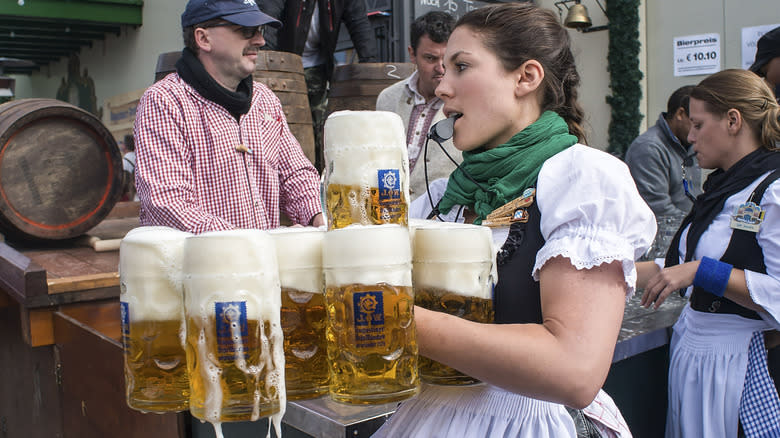
It can be very expensive to visit Oktoberfest, between airfare, accommodation, food, and alcohol, not to mention if you buy traditional clothing or souvenirs. That's why doing your best to stick to a budget once you're there can make a huge difference. The event is free to attend, so be wary of anyone trying to sell tickets. Everything you purchase will be significantly marked up, which quickly makes up for that free entry.
Considering cash is the only way to pay in a beer tent, you'll need to be sure to stock up on euros. If the idea of stopping at an ATM before heading to the party seems like a pain, it will be infinitely worse to wait in line at the ATMs on-site. While you'll want to keep a bit more on hand in case of an emergency, the easiest way to avoid maxing out your budget is to carry a sum you're okay with spending.
As of 2023, a liter of lager (the only format available in the beer tents), will run you between €12.60 and €14.90, or approximately $13.50 to $16. Don't forget to tip — and save money for food while you're at it. Classic Bavarian dishes like roast chicken, pork knuckle, roast duck, sausages, and spätzle cost approximately €15 to €40 ($16 to $43), depending on the tent. If you plan to play games or ride the attractions, you'll need to set aside cash for that as well.
Know The Rules And Come Prepared
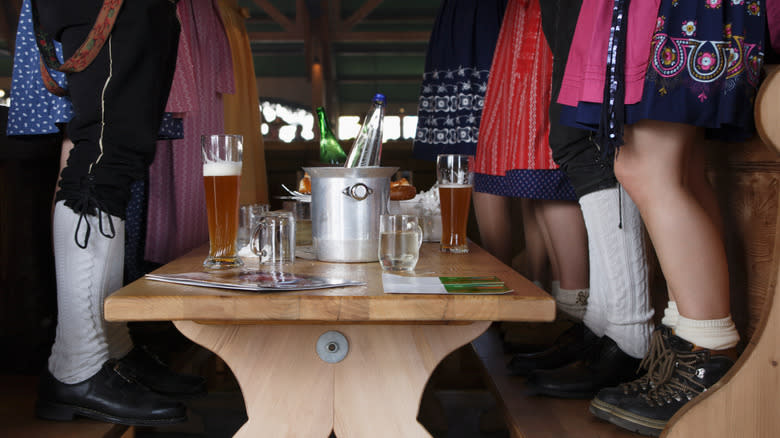
No one wants to get kicked out of a tent, or worse, not even allowed into the festival area. While some rules are more like suggestions based on common sense — say, wearing comfortable shoes to roam the grounds — others might not come to mind if it's your first time attending. Bringing cash with you is more of a necessity than a rule, even though ATMs on-site can supply extra if needed.
Aside from the fact that large bags are forbidden on the grounds, you'll have a harder time moving through the crowds if you're lugging any excess along with you. A small bag measuring approximately 8x6x4 inches is permitted, but leave the rest at home if you don't want to deal with it being refused at the entrance. Depending on the time, strollers may be allowed on-site, but other modes of transport with wheels (like bicycles, scooters, or skateboards) are forbidden. Leave your pets (except for service dogs) and glass containers at home for a smooth encounter with the security controls at the gate. Oh, and no matter how much you'd like to bring a souvenir glass Maß home, do not by any means try to steal it — you're very likely to get caught, as some 100,000 people discovered in 2019.
Read the original article on Tasting Table.

